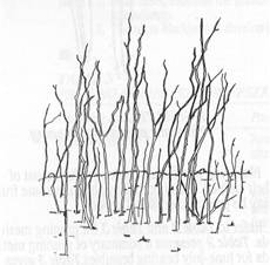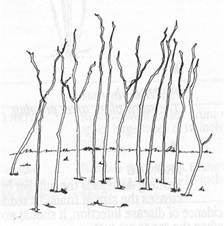It is important to understand the growth and fruiting habits of the various kinds of brambles in order to understand the pruning procedure (Figures 1, 2 and 3). The root systems live for many years, sending up a crop of shoots each year. These shoots live for two years. They complete their growth in height the first season, bear fruit the following summer, and die shortly after fruiting.
New shoots may arise from two places: (1) from buds at the base of old canes, and (2) from buds on the roots. Red raspberries and blackberries produce shoots from both locations. Purple and black raspberries only produce shoots from buds at the plant base or crown. Only the crown and roots are perennial. Summer bearing canes should be removed (pruned) as soon as their fruit is harvested.
Fall bearing or ever-bearing red or yellow raspberries bear fruit on the current season’s growth, flowering first at the tips and then from side branches. Ripening takes place during late August and continues until frost. The remaining lower portion of the cane will bear fruit the following June or July. The portion of cane that bore fruit in the fall will not bear again.
Fall-bearing raspberries can be grown only for the fall crop by cutting back all canes to two to three inches after the fall crop has been harvested. This eliminates the summer crop but the fall crop will be a week or two earlier. This would be beneficial if the garden is located in a frost pocket. See Table 1 for time of pruning.
Pruning
Pruning decreases the number but increases the size of the fruits. To reduce the incidence of disease infection, it should not be done when the canes are wet.
Black and purple raspberries produce most of their crop on lateral branches, although some fruit may be produced on small shoots.
Pruning methods for June – July bearing brambles
| Bramble Variety | After Harvest | Dormant | Late Fall - Early Spring | Shoot Growth Period |
| Red Raspberry | Remove old canes(fruited) | Remove weak canes. Leave 5 to 6 canes per running foot of row. | Space 6 to 8 inches. Narrow row to 12 to 18 inches wide. In early spring remove top ¼ of cane. | Do not prune |
| Black Raspberry | Remove old canes | Remove weak canes. Shorten fruiting laterals to 6 to 8 inches long. | Thin out to 4 or 5 strong canes per hill. | Do not prune |
| Purple Raspberry | Remove old canes | Remove weak canes. Shorten fruiting laterals to 10 to 12 inches long. | Thin out to 4 or 5 strong canes per hill. | Do not prune |
| Blackberry | Remove old canes | Remove weak canes. Shorten fruiting laterals to 12 to 15 inches for thorned types, and 18 to 20” for thornless types. | Pinch off 3 to 4 inches of new shoot when 36 to 48 inches tall. | Do not prune |
Note: 1. In all cases, examine the planting frequently for signs of poor growth. Remove weak plants immediately.
Note: 2. Thornless blackberries develop laterals freely.
Pruning methods for everbearing/fall-bearing brambles
Fall Harvest Only
- Remove all canes to 2 -3 inches after fall harvest.
- Remove weak canes. Prune to space large canes 6-10 inches apart.
Fall and Summer Harvest (Everbearing)
- Remove fruited portion of cane after fall harvest. Remove entire fruited cane after summer harvest.
- Remove weak canes. Prune to space large canes 6 – 10 inches apart.
Training
Brambles may be supported or unsupported. Everbearing types and red raspberries may need extra support to prevent excessive cane drooping. Supports will minimize wind damage and facilitate harvest.
The most common system of training red raspberries and blackberries is the hedgerow, in which the plants are 1-2' apart in rows spaced 10' apart. The plants grow to form a solid row that is kept to a width of 15-18". Each spring the canes within the hedgerow are thinned to 6-10" apart.
An unsupported row system is less expensive than a trellis-supported one, but presents more cultural problems due to closer plant spacing. Black and purple raspberries are usually maintained in unsupported rows in which plants are only allowed to develop from the original crowns. Blackberries, especially trailing varieties, should be grown on a trellis.
If supports are desired, set 6' long treated or untreated cedar or black locust posts 2' into the ground at 25-30' intervals. Nail an 18" cross piece near the top of each post, fasten a 12 gauge wire to each end and run the wire between the posts along each side of the row. Canes are contained between the two wires. Fastenings from wire to wire between posts will reduce wire spreading.

Figure 1a. Dormant red raspberries before pruning.

Figure 1b. Same plants after pruning.
Despite good cultural practices, pests and diseases at times may appear. Chemical control should be used only after all other methods have failed. For pesticide information please call UConn Home and Garden Education Center or your local cooperative extension office.
The UConn Home & Garden Education Center supports UConn Extension’s mission by providing answers you can trust with research-based information and resources. For gardening questions, contact us toll-free at (877) 486-6271, visit our website at homegarden.cahnr.uconn.edu, or reach out to your local UConn Extension center at cahnr.uconn.edu/extension/locations.
Revised by the UConn Home & Garden Education Center, 2019.